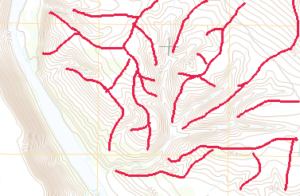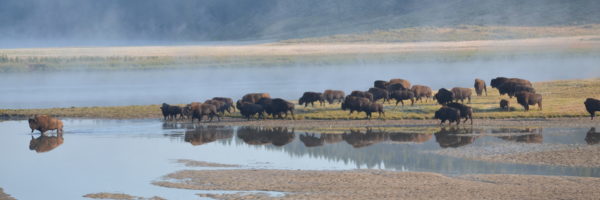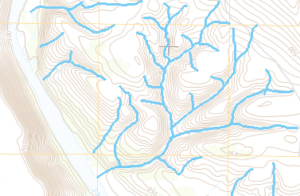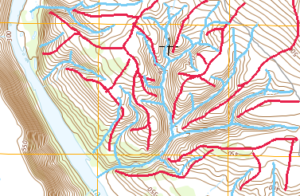“Beauty is not on the map. Seek and ye shall find.”
On the Loose – Terry and Renny Russell, (1967, first of many printings)
All summer, I never left Denali. Like in Big Bend, our work week was scheduled to allow maximum hiking time during our days off (campfire program on one’s first day back). On one’s last day of the week, one would work the early shift, finish with a dog sled demonstration, catch the last shuttle bus into the park, get off somewhere and hike a few hours, sleep, get up and hike all the next day and spend the night in some remote, incredible spot, hang out part of the next morning and hike back all afternoon, camp out, and get up early, hike the hour or two back to the road to catch the first returning bus, and get back in time to be at work for the late shift campfire talk. Five days of work and three days of roaming filled each week. And roaming is a proper word because there were few trails in the park.
Roaming is one of the enduring passions of my life. I am 68 now and still I go roaming alone over the land. So with the Texas desert behind me and the Alaskan tundra stretching before me, let me step out of the chronological sequence of this book to more richly describe this book’s title activity through a scattering of vignettes and explanations.
Early in the courtship of my wife, I invited her to go roaming out in the desert with me.
“Off the trail?” she asked.
“Yes,” I replied with a casual of-courseness.
“How do we keep from getting lost?”
“By staying found.”
My completely-unanticipated answer helped open her eyes to me.
The second most important skill of my roaming is staying found through navigating by drainages. But the most fundamental skill is being able to always take back each step. Don’t step on a place where you will fall or twist your ankle. Don’t step up to a hold on a cliff that you can’t step back down from. Don’t step across a ridgeline without awareness that you are entering a whole new drainage flowing in a different direction. Don’t take that step beyond your food, water, and endurance’s ability to help you make it back.
If you can always take your step back, you can explore almost anywhere. I don’t mean to be cavalier about this. Of course there are a lot more ways to not be able to take your step back than a beginner realizes. I had several “little” encounters in my early years that could have been serious: breaking through snow bridges over invisible creeks, cornices breaking off. A girlfriend noticed that I had developed a habit that if something started to slip, I made a reflexive spring straight up into the air which gives me a second to stabilize before contacting the ground again. But being able to always place your feet in a safe position is the most basic skill of all. With it, the world opens before you, inviting you to roam. You might hit a dead end and have to backtrack, maybe “wasting” several hours. But that possibility is part of roaming, finding one’s own way, and that time is not wasted.
Hiking back from roaming cross-country down in the Grand Canyon, I came upon my first trail in a week. My pace quickened as I followed its smooth path back towards civilization. About a half hour later, I suddenly realized that I had no idea which rock strata I was walking along! That awareness was unneeded on a trail.
For a week, I had always been aware of the rock strata I was on. By strata, I don’t mean the large, hundreds of feet tall formations like the Redwall Limestone or the beautiful Tapeats Sandstone. By strata, I mean the specific rock layers, often only inches thick, that form the individual pages of Grand Canyon’s geologic history, each with its own color and feel underfoot. Some formed my narrow but firm and smooth sidewalks, and others formed my smooth, soft bedroom floors. Changing my line from one strata to another was always a conscious choice. But this awareness was not needed on a trail, and within a half-hour I had lost something that had been a constant.
A trail leads you to a predicted place. Roaming leads you into an unanticipated network of connections. Roaming dances with the land. I move within it, not through it. Off trail, I see several possible lines, ways that I could walk. I say “lines” because “paths” or “routes” call up images of ways that have already been marked by the feet of others. My lines are inspired solely by the shape of the land, the intertwining of drainages and ridges, the way a slope combines light and shadow. The closest thing I can compare this to is skiing untracked snow. The snow covers and smooths all the land into curving shapes. Certain routes beckon with the promise of a more exhilarating dance with the land’s beauty.
Roaming swoops in and out, flowing over the land in a way that brings out its sensuous shape. Each step changes what I see which changes where I place my next step which will change what I next see. My walking is being shaped through a constant feedback spiral; that is roaming. The more responsive I am to what I am seeing each second, the more alive grows this spiral and the more alive becomes my roaming. My path is unpredictable. Not random; in retrospect it has a strong line through it: flowing up hills, cruising around small headwater drainages, following a meandering streambed. A line shaped by fascination, beauty, pleasure. “Beauty is not on the map. Seek and ye shall find.”
I’ve written in “The Language of Streambeds” how converging drainages shape the land into a fractal pattern. This creates a certain kind of experience that always surprises me delightfully when it happens. When I’m roaming, the land sometimes expands in a way I did not anticipate. I can roam an area over several years and think I know it. Then one day, I follow a side drainage up to a low, gentle pass with a clear idea of what will be on the other side and walk into a drainage system I had no idea was there. The land is larger when I roam. My mental map of the area keeps bulging bigger in places I thought were small. The area has more dimensionality when I roam within it than when I follow a trail through it.
And so much beauty. This is especially true going up steep slopes. The easiest way to ascend a slope is with a series of small, uniform steps, like walking up a stairway. When I strive for this, I see stairways of lines zig-zagging up the slope. Some of the stairways are absolutely beautiful, beckoning with rocks placed just so, calling me up the slope. The surer I am in my ability to place each foot in exactly the right place, the more lines open up, delicate and beautiful elf staircases.
My first backpack trip was as a twelve-year-old Boy Scout on a six-mile ascent to a mountain meadow. I was the tired straggler at the back of the line, longing for any excuse to stop and get the heavy pack off my shoulders. Rarely did the trail go briefly downhill, allowing me to coast and catch my breath. Each time I came around a curve in the trail, I looked yearningly ahead to see if the trail might go downhill. Usually all I saw was the trail rising ahead of me – much to my frustration. I really, really wanted that trail to have lots of downhill stretches.
I lacked the big picture. I didn’t realize that if our destination lay above us, then any downhill stretch would require an additional uphill stretch later to compensate for it. An uphill trail with downhill stretches requires more energy than an uphill trail with no downhill stretches. If I’m going uphill, I want a trail that holds steady with whatever grade is needed to reach its destination. I’ve come to have a deep respect for the maker of such a trail.
Some of the masters of making such trails are the animals that spend their lives in this place, as did their furbearers before them. Over the centuries, their trails have evolved least-energy solutions. “How do we expend the least amount of our limited energy to cross that ridge? We cross it at the lowest point possible. No need to gain extra elevation if we are then just going to drop down the other side. Before the day is over, our energy reserve might determine whether we survive or die. Don’t waste it! The elevation we do gain, we gain smoothly at a steady grade. In this way, we retain more of our energy for other possibilities. What is the most efficient way to drop down on the other side to the easiest place to cross the next creek?” Animal trails fit into the shape of the land and knit ridges, streams, me and the other animals together with sinuous lines.
In Denali National Park, I followed the Dall Sheep trails along narrow ridgelines that rose and fell. Looking ahead to the next rise, I could not see what lay beyond, but the Dall Sheep knew. If their trail followed the ridgeline, that meant that the ridge kept rising beyond where I could see. As I crest that rise, I will see the ridge beyond ascending higher still. But if their trail skirted around the side of the rise, that meant that the rise ahead is a “bump” upon the ridgeline and will drop back down to meet the sheep trail that saved energy by skirting around it instead. If I’m in the mood for a view, I can follow the ridgeline; if I’m in an energy-conserving mood, I follow their trail.
We usually don’t encounter animal trails for two reasons. The first reason is that our trails are created to help us move quickly through an area. Animal trails are collectively created to help live within that area. Therefore, the trails are shaped by different purposes and usually occur in different places.
The second reason is that animal trails are much narrower. Animal trails, less than a foot wide, nestle right into the slope, often going where ours cannot. Plus the trail has been there so long that the land has adjusted around it. Animal trails disturb so little that they don’t call attention to themselves. On an animal trail, I feel like I am walking within, not through, the world and it just happens that my every step comes to rest on conveniently-graded ground.
However, in my pursuit of beauty, my roaming usually takes me off the animal trails too. I love walking upon land unwritten by trails where each step is shaped by lines. The land is full of lines. The first set of lines most hikers become familiar with, thanks to contour maps (left diagram), are contour lines.
Each sinuously curving line indicates the places that are at the same elevation above sea level. Each contour line marks the shoreline of a lake if the land was flooded to that height (as shown to the right). Contour lines that are close together (as they are on the left side of the river) indicate very steep slopes. The farther apart the lines, the less steep the slopes. This makes sense; one has to walk farther along a gentle slope to ascend ten vertical feet to the next contour line.
A second kind of line is the fall line. Wherever you are standing, if you released a big ball so it could roll down the slope, the ball would follow its fall line. The fall line is perpendicular to whatever contour line you are on.
A special member of the fall lines are the drainage lines (blue on the map below. The drainage line is the longest fall line that all the shorter fall lines in the area converge with. It’s also the least steep of these fall lines because more water flows along it than any other fall line. Therefore it has been worn down more. The blue lines reveal the major drainages of that map. Studying the little indentations in the contour lines reveal smaller drainages. The drainages converge as they flow down the slopes.
A fourth set of lines are the ridgelines (red lines on the left), the yang to the drainage lines’ yin. Ridgelines diverge as they move down downslope.  This reversal between converging drainages and diverging ridgelines allows drainages to nest within the ridgelines (on the right). This wonderfully complex interplay shapes the land and makes my paths continuously curve in and out between the two.
This reversal between converging drainages and diverging ridgelines allows drainages to nest within the ridgelines (on the right). This wonderfully complex interplay shapes the land and makes my paths continuously curve in and out between the two.
I am very aware of all these physiographic lines as I roam over the land. Just as there is a direct relationship between the drainage lines and the ridgelines, and a direct relationship between the contour lines and the fall line, so there is a direct relationship between all four of these and the fifth line of the animal trails, the paths of least energy. The balance between the five is changing all the time. Sometimes a beautiful stratum invites me along its contouring sidewalk. Other times the fall line invites me to glissade straight down a snowfield. I navigate by drainages until I’m high enough to climb to a ridgeline and follow it upward as it converges with other ridgelines towards the summit.
From this interplay of five lines, the line I walk emerges: a beautiful line of aliveness. This line is responsive to all the other lines and yet is the line I actually follow without knowing where it will lead or by what line I will eventually circle back towards my starting point. Often the beauty of the space and its shape stop me. I breathe it in. The light, the beautiful light glowing all around me. The enoughness – of being here – in this space.
Life is roaming. If I believe that in every moment, a possibility might open that could lead me onto a whole new life path, then I am more attuned to possibilities. They are part of my search image as I scan the line ahead of me. I meet a birdwatcher and I’m off to Alaska. A ranger suggests I watch what happens to a dead deer and my teaching changes. Ahead are many stories where something unanticipated leads me onto a new exploration that, in turn, leads to other unanticipated encounters so that you aren’t sure where this story is going to end up.




